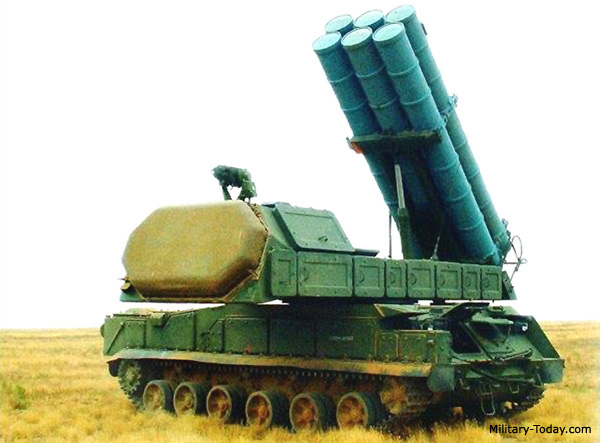The new Buk M3 has much improved capabilities comparing with older Buk systems
Length ?
Width ?
Height ?
Missile
Missile length ?
Missile diameter ?
Missile weight ?
Warhead weight ?
Warhead type HE-FRAG
Range of fire 2.5 - 70 km
Altitude of fire 35 km
Number of missiles 6
Mobility
Engine diesel
Engine power 840 hp (?)
Maximum road speed ~ 65 km/h
Range ~ 500 km
The Buk M3 (
beech) is a brand new Russian air defense system. It uses new missile and has advanced electronic components. It has much improved capabilities comparing with the older
Buk systems. It outperforms even the old
S-300P long-range air defense system.
Development of the Buk M3 began back in 1990. Development process was plagued with delays. This new air defense system has already been tested by the Russian armed forces. It is scheduled for production. The Buk M3 could be adopted in 2015 or 2016. Russian military officials state, that first operational Buk M3 systems will be delivered to the Russian Army in 2016. It is planned that it will replace the older Buk M1 systems.
This air defense system can engage tactical and strategic aircraft, helicopters, short-range ballistic missiles, cruise missiles, air-launched missiles, anti-radiation missiles, guided bombs and other aerodynamic vehicles. This air defense system can operate in heavy enemy jamming conditions.
A Buk M3 TELAR vehicle is fitted with radar, missile erector and launcher, and friend or foe identification system. It is operated by a crew of 4. TELAR carries a pod with 6 containerized missiles. Such modular approach speeds up reloading of the vehicle. Also it is significant improvement over older Buk systems, that carry only 4 missiles.
Radar of the Buk M2E TERAL searches for targets, tracks them and guides missiles on them. The system has a third generation phased array fire control radar.
Also there is a TEL vehicle that lacks radar, but carries 2 pods with a total of 12 missiles. It acquires firing data from the Buk M3 TELAR vehicle, or command post vehicle. Essentially this unique launcher vehicle acts as a force multiplifier. Similar concept was used on the older Buk systems. However these use reloading vehicles, that can launch missiles themselves, rather than separate TELs.
The Buk M3 uses a new 9M317M missile. This missile was first publicly revealed in 2006. It has a totally different design that older Buk missiles. It is more compact than missiles, used on the Buk M1 and Buk M2 systems. Performance of the new missile improved significantly comparing with the older Buk missiles. The new missile has a range of up to 70 km. Maximum altitude is 35 km. Minimum range of fire is 2.5 km and minimum altitude is around 15 meters. The missile is fitted with high-explosive fragmentation warhead. In case of emergency missiles can be launched against contrast surface targets, such as ships.
Missiles of the Buk M3 are stored in and launched from containers. It is worth noting that the Buk was the last Soviet/Russian mobile air defense system, that had its missiles stored openly, rather than in containers.
A prototype TELAR of the Buk M3 was based on a GM-569 special tracked chassis. This vehicle is powered by a diesel engine. It seems that it develops 840 hp. However some sources report that production version will be based on a new GM-5969 tracked chassis with 7 roadwheels. It takes about 5 minutes to prepare vehicle for launch from traveling.
Normally the Buk M3 TELAR operates as part of an air defense unit. A battery of Buk M3 TELARs and TELs is controlled by an automated control system. There is also a command post vehicle, detection and target designation radar, and reloading vehicles. A battery of the Buk M3 can engage up to 36 air targets simultaneously. However if required each TELAR vehicle can operate autonomously.
Reloading vehicle of the Buk M3 will be based on a BAZ 8x8 wheeled chassis. This vehicle has good cross-country mobility. It is fitted with a crane and carries 4 pods with a total of 24 missiles. Modular arrangement of the missiles allowed to speed up reloading.
Can't find what you're looking for?













